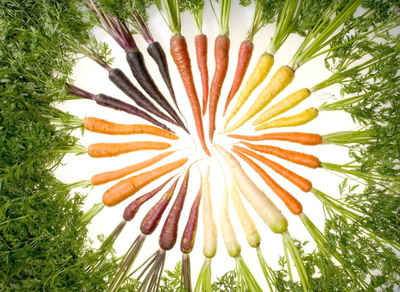Anti-oxidative nutrition
Experiments with diet and fruit and vegetables whic have anti oxidative nutrition
 The simplest way to obtain these natural phyto-chemicals is through nutrition (SEE chap. 1). A daily diet should be based on 8-10 servings of fresh, biologically grown vegetables, well washed (at least four times), fresh fruit, seeds, green leaf vegetables and tubers. The choice of foods is very important, they must be guaranteed to have been grown free of any anti-parasite solutions and/or pesticides, given the widespread pollution of the environment existing in Europe today.
The simplest way to obtain these natural phyto-chemicals is through nutrition (SEE chap. 1). A daily diet should be based on 8-10 servings of fresh, biologically grown vegetables, well washed (at least four times), fresh fruit, seeds, green leaf vegetables and tubers. The choice of foods is very important, they must be guaranteed to have been grown free of any anti-parasite solutions and/or pesticides, given the widespread pollution of the environment existing in Europe today.
Supplementing such a diet with fruit and vegetable juice concentrates improves the immune defense system. The cyto-toxicity of the Natural killers can increase from 25 to 100 times, with significant increases even in Interleukine 2, Interleukine 6 and a proliferation of the T cells (630).
Furthermore, the same addition of fruit and vegetable juice concentrates reduces the oxidative damage to the DNA of the peripheral lymphocytes by about 60% (631).
Of the common carotenoids contained in food, beta-Carotene, alpha-Carotene, Lycopene, Lutein, Zeaxantine and Cantaxantine have demonstrated a potent anti-oxidative, immune-modulating action and the possibility of influencing the genetic expression, improving the ratios of intercellular connection bond (635). http://www.mednat.org/alimentazione/Nacci_vitamine%209.pdf
The carontenoids Lutein and Zeaxantine, which are found mainly in dark green leaf vegetables (e.g. spinach), have also proved to be effective.
Table 5:
Hematic values to be searched for, according to the anti-oxidative levels present in cancer patients with an Immune Cascade under way:
Total Tocopherol
Alpha-Tocopherol
Gamma-Tocopherol
Total carotenoids
Lipidic profile
Glutathione
Pholates
Vitamin B12
Lipidic peroxides (e.g. Malondialdeide)
Urinary levels of 8-hydroxic-Deoxiguanosine
Anti-oxidant reserve capacity of the hematic serum
High levels of natural anti-oxidants such as carotenoids, tocopherols and ascorbic acid have been studied, to test eventual positive changes in the pathologic progress of serious illnesses such as cancer. The long term practical studies have almost always shown that single nutrients like beta-Carotene have disappointing results, because the anti-oxidants are effective only when combined and taken in a wide spectrum (at least 13,000 vitamin principles and co-enzymatic factors of different types). Thus, the respective levels of carotenoids and of Tocopherol in human plasma have been measured, following the integration into the diet of commercial extracts of fruit and vegetables. Then, the effectiveness of this integration in modifying the oxidizing processes was established, measuring the levels of the lipidic peroxides present in the hepatic serum: 15 healthy adults took these commercial extracts twice a day, at mealtimes, for 28 days; samples of plasma and serum were taken before the start of the study, and at day 7, 14 and 28.
After 28 days, the anti-oxidative levels in the blood, especially Lycopene, increased to a significant extent:
Beta-Carotene: + 510%
Alpha-Carotene: + 119%
Lutein/Zeaxantine: + 44%
Lycopene: + 2046%
Alpha-Tocopherol: + 58%
Retinol: + 14%
On the contrary, the level of lipidic peroxides in the blood serum decreased by 4 times after 7 days, stopping at a level of -75%. The decrease in the level of lipidic peroxides coincides with an increase in the carotenoids and alpha-Tocopherol, as a logical consequence of the functional improvement of the defense mechanisms against oxidation.
Similarly, gamma-Tocopherol also showed a drop in the hematic concentration (-38%), because of the continuous oxidative stress by the normal flora bacteria; this anti-oxidative process guaranteed by gamma-Tocopherol is due to the liver and the bio-availability in the diet of alpha-Tocopherol.
When the latter is present in adequate amounts, gamma-Tocopherol is „consumed“ in particular parts of the body such as the intestine, thus showing a slight but continuous level of low concentration. Vice versa, when there is a lack of alpha-Tocopherol, the liver tends to save the consumption of gamma-Tocopherol, thus raising the hematic levels of the latter (636).
Another experiment (638) which integrated commercial extracts of fruit and vegetables into the diet of 16 adults, showed the following values of plasmatic concentration after the seventh day of therapy:
1) beta-Carotene: increased to stable hematic concentrations of 0.5 microMols/liter
2) vitamin C: increased to about 3 times as much, reaching stable hematic concentrations of 60 microMols/liter
3) vitamin E: increased up to stable hematic concentrations of 3 microMols/liter
4) malondialdeide plasmatic level, considered a general peroxidation indicator, decreased by about 40%.
In another experiment (638), which integrated commercial extracts of fruit and vegetables into the diet, after 3 months of supplementing the diet with 18 milligrams a day of beta-Carotene, 900 milligrams of vitamin C and 200 milligrams of alpha-Tocopherol, the plasmatic concentrations increased respectively by:
Beta-Carotene: + 500%
Vitamin C: + 55%
Alpha-Tocopherol: + 27%
An integrated diet
Eight-ten portions a day of fresh fruit and vegetables is a strict regime to follow both for the patient and the family, because it implies a continuous feeding program, but it must be followed, perhaps in small portions.
The author considers that it is necessary, for an anti-oxidative effect, to integrate fresh vegetables (fruit, vegetables, green leaf vegetables and tubers) with the products already listed in chapter 1.
Source: The book Thousand Plants against Cancer without Chemo-Therapy, author Giuseppe Nacci, M.D
